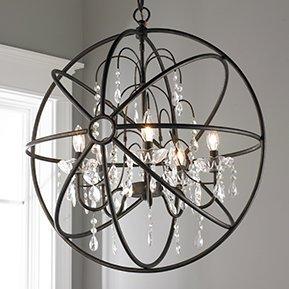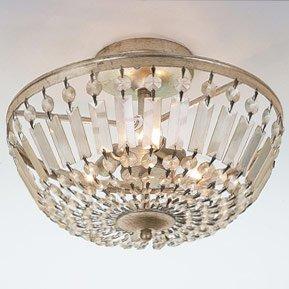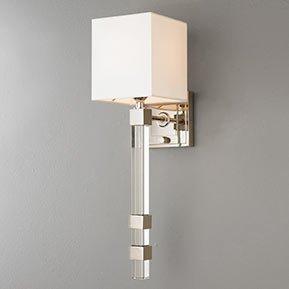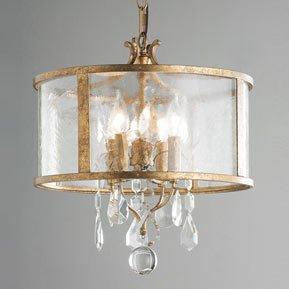- Home
- Blogs
- Design Guides & Tips
- Types Of Crystal
Types of Crystal
Tags: Crystal Lighting
By: Shades Of Light
Date: December 08, 2021
There is no great mystery in discerning the quality levels of crystal. In fact, the level of quality is as the phrase implies “crystal clear”. Glass trim reflects light while crystal trim refracts it. Within a solid white environment, glass will have no color. Crystal, on the other hand, will still display fire and brilliance regardless of the presence of color. All that is needed is light.
Strass crystal
Strass crystal is considered the highest quality of crystal trim throughout the world. Swarovski Strass, manufactured in Austria, is considered the premium brand of Strass due to a patented anti-dust coating (an invisible optical coating making it easier to clean and maintain) and name recognition. The term “Strass” means “perfect surface of glass” and contains lead quantities of 30% or more. The machine polishing leaves no trace on the surface of the crystal and the hand polishing creates perfect optic clarity, razor-sharp faceting and unique purity and brilliance. And to protect buyers against imitations, the Strass logo is laser etched into miniature inside each crystal piece.
Gem cut, Egyptian, or Spectra Lead Crystal
Gemcut, Egyptian, or Spectra lead crystal (made with 24%-30% lead oxide) is some of the finest refractive crystal. There is no noticeable difference between 30% and 24% machine-polished lead crystal. Lead improves clarity and softens glass for cutting. Though not as expensive as Strass or Swarovski crystal, this crystal is characterized by a prismatic brilliance, visual purity, sharp faceting and precise polishing all its own. Spectra Crystal is manufactured like Strass crystal but without the optical coating.
Turkish, Heirloom, Bohemian, Czech Crystal
This crystal uses a mixture of oxides other than lead, such as soda ash, to achieve high optical clarity and refraction of light that closely rivals full-lead crystal. The EU certifies that glass must contain at least 10% oxides to carry the label “Crystal”. In fact, one would need a piece of both lead-free crystal and full-lead Strass crystal to notice the difference between them. What you would see is approximately 10% more color/fire in the Strass crystal and no noticeable trace of polishing within the facets. The difference in price is what makes lead-free Bohemian Crystal a value in comparison to full-lead crystal.
Murano Glass
Made in Italy on the island of Murano, authentic Venetian crystal combines quartz, soda, sand, potassium, and lead oxide at very high temperatures. The glass is blown and stretched by hand allowing artisans to create delicate floral and other unique shapes.
Wood-Polished Crystal
In a labor-intensive process, wood-polished crystal is first cut by hand in two stages on iron and then sandstone grinding wheels. Then each crystal is polished on a wood wheel with marble dust. You may notice faint traces of the wood wheel in finished pieces, a mark of authenticity.
Italian Crystal (Legacy, Venetian)
This lead-free crystal is used in antique reproductions to accurately reproduce the antique since lead crystal wasn’t invented until the 17th century. Italian crystal comes from the historic glass-making region around Venice and has a look and feel all its own. Italian crystal is molded and fire-polished rather than hand or machine cut, resulting in a beautifully subtle luminosity. Fire-polished crystal is characterized by concave facets (instead of flat facets), the appearance of a slight texture within the crystal, lessening optical clarity, and a noticeable characteristic of reflecting color in the environment instead of refracting light into a prism of color within the crystal. It is modestly priced, compared with hand-cut crystal.
Lead-Free crystal
Machine-polished lead-free crystal is the closest quality level to Strass crystal. High-quality machine polishing leaves no trace of the polishing on the facets of the crystal. While this is less expensive than Strass Crystal, there are many who would argue that its handcrafted nature elevates it above machine made crystal. When looking closely into the facets of hand-polished crystal, one can see slight grooves in the crystal left by the polishing wheel, as each facet of the crystal was pressed by hand and individually polished. These slight grooves, apparent only from very close scrutiny, lay testament that it is a handcrafted piece of crystal made of exceptional skill and craftsmanship. Many people within the industry have mistaken this crystal for Strass.
Pressed Glass & Chinese Crystal
Generally made from sand, soda, and lime heated in furnace and then pressed (molded), or “drawn” (re-shaped), this type of glass is the least expensive. Chinese crystal is cut and polished like more expensive grades, but lacks the high optic quality and precision facets. Seams are usually visible in pressed glass lamps and prisms.
Rock Crystal (Quartz Crystal)
Not real crystal glass at all, rock crystal is crystal rock that is mined, not manufactured. It cannot be mass-produced. Each rock crystal is completely unique, created by geological events and pressures taking place over millions of years. Authentic rock crystal bears a unique mark from this process, and can be identified both by visual appearance and by touch – it remains mysteriously cool to the touch no matter what the surrounding temperature. Raw quartz is mined in only a few remote locations. Rocks are hand selected, then ground, cut and polished entirely by hand – an expensive process. Polishing one piece can take a week or more because of the natural complexity of the rock material, and the rejection rate for imperfect pieces can be 12 to 1 or more. Used extensively until crystal glass manufacturing methods were invented, rock crystal is generally used today in specialty lighting fixtures and custom designs.
Aurora Borealis Crystal
Clear crystal needs direct light to really create lovely rainbows on nearby surfaces, while the Aurora Borealis crystal looks beautiful even without direct light. The Aurora Borealis treatment is applied to one side of the prism and looks like a multi-colored rainbow that is reflected through the prism.





